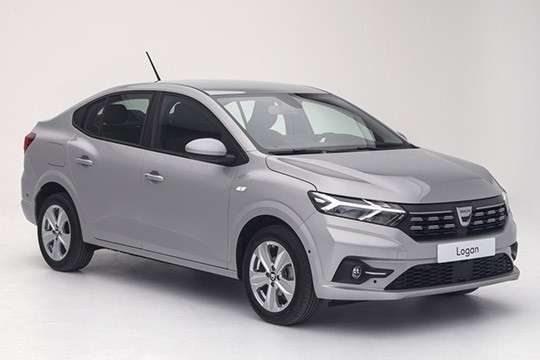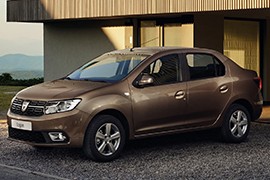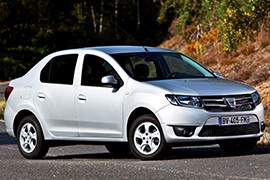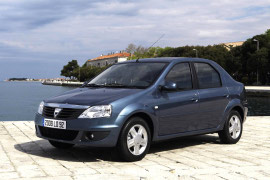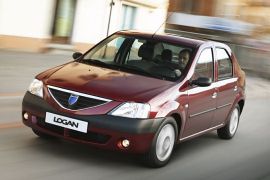DACIA Logan Models/Series Timeline, Specifications & Photos
First production year: 2004
Engines: Gasoline, , Natural gas, Diesel
The Romanian brand Dacia unveiled the third generation of the Logan range at the end of September 2020. It was a complete makeover of the low-budget car.
The Romanian car-company Dacia was part of the Renault Group when it introduced the Logan lineup's first generation. That car was built mainly for the Romanians and East Europeans with a base price lower than a set of light-alloy wheels from Rolls-Royce. Its exterior design was not a concern for the customers. The second generation started to look better, but the 2020 model brought more appeal to it.
A completely new design, with bold headlights that incorporated the LED daytime running lights, a hexagonal 3D grille, and an A-shaped lower grille in the apron, made the car look aggressive. The wheel-arches were wider than the rest of the bodywork, and the sculptured door panels looked better than before when they were just slightly curved. Due to the sloped rear windscreen and the higher trunk area, it seemed like the greenhouse was shorter.
The interior design team worked hard and brought smart solutions for the customers. On top of the dashboard, smartphone support with a lid on top of the dashboard plus a USB connection transformed the driver's personal mobile phone into a media control unit. The top of the range version featured a Media Nav system with wireless integration for Apple CarPlay and Android Auto. Due to the longer wheelbase than its predecessor, the Logan offered more legroom for the rear passengers.
At the time of its launch, the Logan was available with a choice of three engines. The base version featured a 1-liter, three-cylinder unit. A turbocharged 1-liter unit powered the mid-level, and the top version was the 1.0-liter bi-fuel (gasoline-LPG) engine that developed 100 hp.
The Dacia Logan is a more family oriented vehicle produced by the French producer Renault in collaboration with the Romanian subsidiary Dacia.
The first generation of Logan was released back in 2004 and the new 2016 model was part of the 2nd generation, only a facelifted version of it.
The Logan was mostly known as a basic, reliable and durable car. It was designed to take people from A to B.
The Logan was available in a sedan, MCV or a van body shape, to suit all needs. It was mostly bought by people with a low-budget, for employees or as taxi cars.
In 2016, Dacia presented their first automatic transmission called Easy-R.
Design wise, the new Logan sedan had a refreshed interior and exterior, making it more attractive to the buyers.
The changes include a redesigned headlamps and taillights, as well as the LED daytime running lights had a “pattern of four stacked rectangles”, as Dacia says.
Both the front and the rear bumper were redesigned to give the impression of a more muscular look.
The interior of the Logan was very roomy, with a good driving position, comfortable seats and intuitive simple controls. Even if the plastics used for the dashboard and door trims were hard plastics, the overall design looked fresh.
Unexpectedly, the trunk space was enormous. So if you’re thinking to take half of your house with you, you might as well do it. The load area had a capacity of 510 L.
The basic Logan designed to be a people’s car was a little bit over $13,000 with most of the optionals included.
After eight years on the market, the Logan finally got a successor that fixed most of the problems encountered in this car's first generation.
In 2012 Dacia unveiled the second generation of the Logan at the Paris Motor Show. Europe already knew this brand and nameplate since it was sold well during the 2008 world financial crisis. Moreover, the automaker listened to its customers and introduced more features and amenities for the car.
Not paying the exterior design team with lunch money paid off, and the second generation of the Logan got a nicer exterior. Thus, the headlights were slightly swept-back, and the two-slat grille was adorned with chromed elements. In addition, both the front and rear fenders showed a muscular stance due to their flared stance. In addition, the flush door handles and the door mirrors' caps were body-colored for a much more modern look.
Some of the most significant upgrades were for the car's interior, which provided room for five adult passengers, and a 60/40 split-folding rear bench. Yet, the front seats were still flat and covered with cheap fabric. For the dashboard, Dacia chose a new design with organic shapes and silver trims. In addition, as an option, the Romanian automaker offered an option for a touchscreen infotainment system on the center stack. Even though it wasn't mounted in the most accessible position, it was still an improvement compared with Logan's previous generation.
Under the hood, the automaker relied on Renault-sourced engines, either gasoline or turbo-diesel. All versions sent their power to the front wheels via a five-speed manual transmission. Later on, Dacia offered an option for an in-house developed robotized, single-clutch, automatic gearbox.
Already a big seller in Romania at least, the Dacia Logan got a facelift for 2008.
While both the exterior and the interior design were updated, the engines remained the same old versions.
4 years after the Logan’s launch, Dacia redesigned its flagship model to maintain the title of the best sold model obtained in 2005.
The subtle changes brought to the exterior design consisted of a new grille and a redesigned logo, as well as the chrome accents added to the grille for extra style.
The exterior mirrors were enlarged to provide a better view, while the front spoiler was restyled and thus increased the model’s dimensions by 4 cm.
From the back, the aileron became part of the trunk lid. The trunk size remained at the impressive 510 L, a record in its class.
For the interior, the Logan came with better quality materials and two-tone colors used for the dashboard to make it more attractive.
3 new cloth upholstery became available with the 2008 version.
Safety wise, the new Logan came with seatbelt pre-tensioners, frontal and side airbags and ABS.
The engines available were a 1.4-liter gasoline engine, a 1.5-liter diesel engineand a 1.6-liter engine that developed 105 hp.
Never designed to be a performance or a luxurious car, the Logan came with a starting price of around $6200, with the top version reaching around $10,200.
The Dacia Logan was the first car produced by Renault from scratch. The car created lots of controversies around it, being a cheap one to buy, but not offering many features or high-quality materials.
The reason why the Logan sold so well was, of course, its price. Many people chose to have a new car with spare parts that were cheap and easy to replace. The Logan represented simplicity for the masses.
The trunk space was acceptable consisting of 510 l and the cabin itself was roomy due to the car’s shape, it offered enough legroom and headroom for 4 passengers.
The car came with 3 gasoline engines and 1 diesel engine that developed 65, 70 or 85 hp. The gasoline engines were a 1.2-liter with 75 hp, a 1.4-liter 75 hp or a 1.6-liter MPI producing 95, 100 or 105 hp. The 105 hp engine did quite well along with the car’s reduced weight and its performances were comparable to those of a BMW E46 with a 2.0-liter engine. All engines were mated to a 5-speed manual transmission.
To keep its price low, the Logan’s non-galvanized body rusted pretty fast plus it could be bought without ABS, climate control, power windows and power steering.
The Logan was not one of the safest cars on the streets and scored only 3 stars at the EURONCAP crash test.
Overall, it was a good car at a low budget, easy to maintain and extremely reliable.
